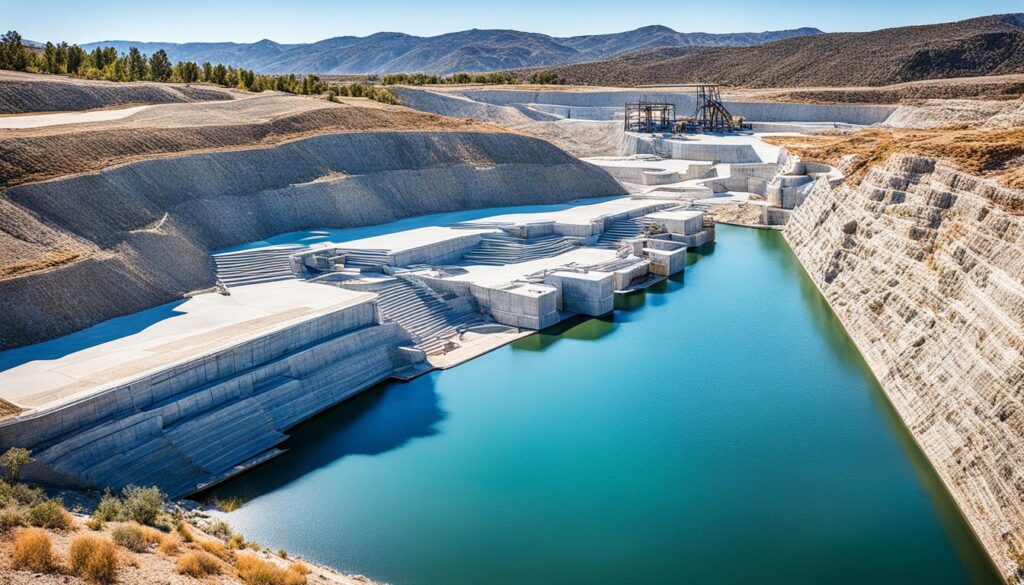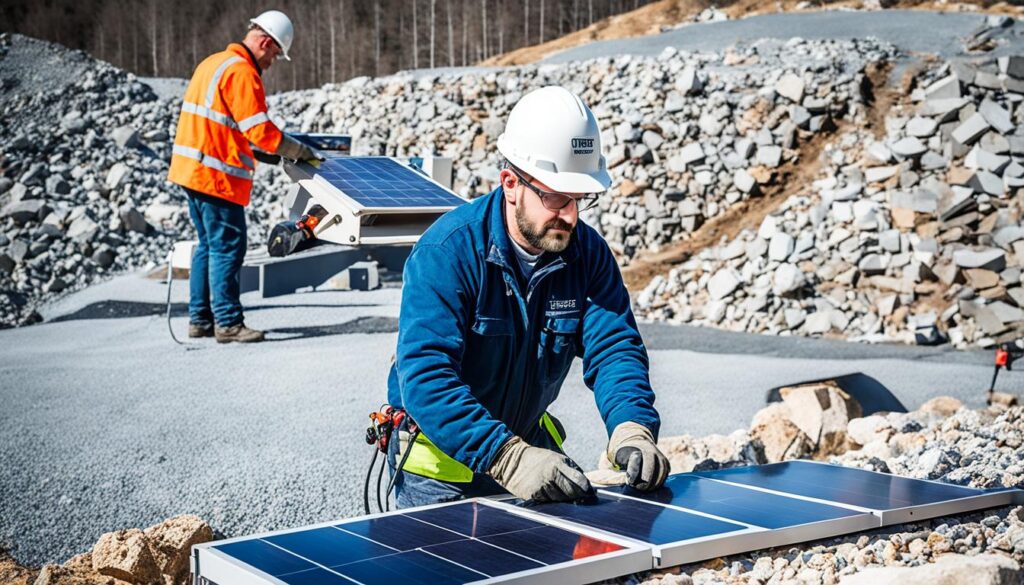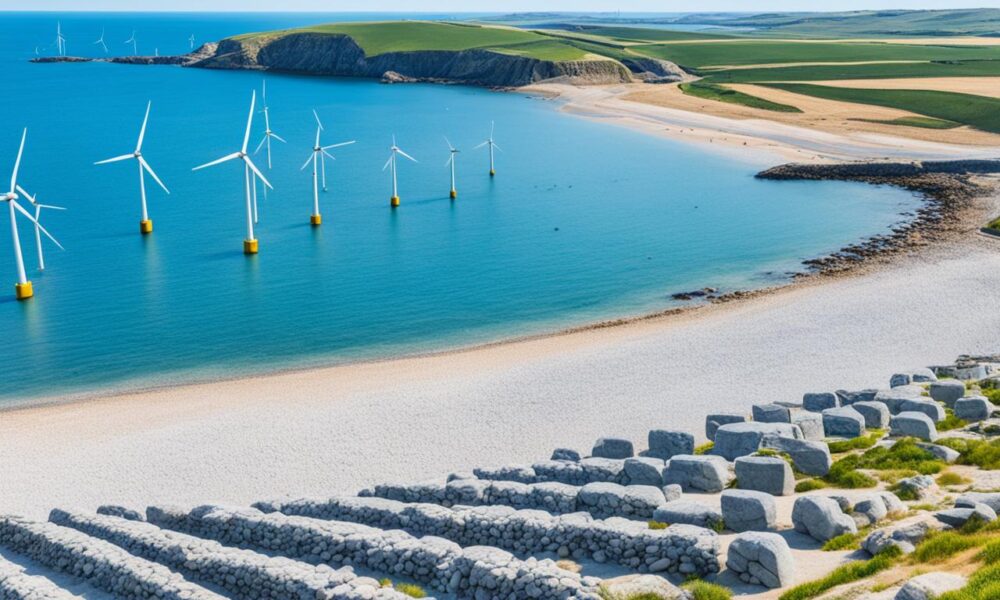Eco-Friendly Stone: Sustainable Practices Insight
Eco-friendly stone is made from materials that last long and help the planet. Sustainable Practices in the Natural Stone Industry have proven that natural stone is a top pick. It is strong, has low energy use, and is VOC-free. This means it’s a great choice for the environment when building.
Natural stone is a better option than materials made with lots of chemicals. These can hurt the earth and people. Thanks to its simple, natural design, using natural stone helps us make more eco-friendly choices in construction. It supports efforts for sustainable and green building.
Key Takeaways
- Nearly 100% of natural stone from deconstructed projects can be recycled or reused.
- Light-colored stone helps reduce heat absorption, minimizing “heat island” effects.
- Regular maintenance extends stone longevity, enabling the use of mild cleaning agents.
- Domestic quarries meet strict environmental guidelines with reclamation plans.
- Local sourcing reduces greenhouse gas emissions due to shorter transportation distances.
Understanding Eco-Friendly Stone
In recent years, there’s been a lot of talk about eco-friendly stone. It’s part of an effort to make the stone industry more green. This is all about using natural stone in ways that help the earth and our health. Let’s explore why natural stone is a great choice.
What Makes Natural Stone Sustainable?
Natural stone comes from the earth. It doesn’t need a lot of processing like some other building materials. Because of this, it’s good for the environment. The strong, long-lasting structure of natural stone also means we don’t need to use as many resources over time. This reduces the stone’s impact on the planet.
Today, quarrying is being done in better ways. Companies are using methods that waste less water and energy. For example, more than 95% of the water used in quarries is now recycled. They’re also switching to electric vehicles to reduce pollution. Plus, by using LED lights and avoiding paper use, they’re cutting down on energy waste. These steps are important for the industry’s future.
Key Characteristics of Eco-Friendly Stone
Natural stone is good for the planet in many ways. It doesn’t release harmful chemicals (VOCs) into the air. Plus, it can be used again and again, which means less waste.
Choosing natural stone helps local businesses and the environment. By getting materials from nearby quarries, we cut down on how far they have to be transported. That means less pollution. Also, choosing environmentally friendly quarries supports long-term earth protection. It’s all about creating a greener, healthier future.
Health Benefits of Using Natural Stone
Using natural stone is not just good for the earth. It also makes our indoor spaces healthier. Natural stone doesn’t contain toxic materials, which means it’s safer for us and the planet.
Building with natural stone lowers the carbon footprint of our buildings. For example, using local transportation reduces pollution. This makes natural stone not only eco-friendly but also better for our health. It’s a win for both the environment and people.
Sustainable Practices in the Natural Stone Industry: A Closer Look
To understand Sustainable Practices in the Natural Stone Industry, we must look at the tools that measure the impact on the environment. Two key tools are Environmental and Health Product Declarations (EPDs and HPDs). They show how natural stone is sourced and made in ways that are good for the environment and our health. These documents provide solid facts about the benefits of using natural stone. This helps people make choices that are better for the environment.
The Role of EPDs and HPDs
EPDs and HPDs show that natural stone is sourced and manufactured responsibly. They give detailed information on the environmental and health impacts of these products. This information is very important for those who want to build in a way that is green. These declarations make sure that using natural stone supports a sustainable future.
Comparative Analysis with Other Building Materials
When we compare natural stone to other common materials like quartz and precast concrete, natural stone performs better environmentally. It has low levels of carbon and uses very little energy to get out of the earth and be made ready for building. These facts show that natural stone is a top choice for construction that cares about the planet.
| Aspect | Natural Stone | Manufactured Quartz | Precast Concrete |
|---|---|---|---|
| Global Warming Potential (GWP) | Low | High | High |
| Embodied Carbon Levels | Lowest | Moderate | High |
| Energy Consumption for Processing | Minimal | High | High |
Industry Standards and Certifications
Standards and certifications, like NSC/ANSI 373, are key in showing that natural stone is truly sustainable. These are recognized by programs that focus on green building. They look at the stone’s whole life, from where it’s sourced to how it’s used. The use of certified stone in big projects proves that sustainability is possible in construction.
Not just in sourcing and making, quarries like INDIANA LIMESTONE® in the U.S. and CAMBRIAN BLACK® lead the way in being green. They recycle water, reduce waste, and handle chemicals in safe ways. This underlines the green wins of choosing natural stone.
These practices show that natural stone is a strong choice for building in ways that protect the Earth and our future. They make natural stone even more appealing because they help the environment.
Environmentally Conscious Quarrying
Environmentally conscious quarrying is key to sustainable stone practices. It uses methods that are efficient. These methods also protect the environment and help communities.

Quarry Reclamation and Environmental Stewardship
Reclaiming quarries is vital for the environment. It’s about renewing them after stones are taken out. Coldspring reuses grout and debris for various projects. Meanwhile, Quarry Park and Nature Preserve in Minnesota is a big example of successful reclamation.
Technological Advances in Quarrying Practices
Technology is changing the game in quarrying. It’s making the process less harmful. For example, Vermont Quarries uses a large underground marble quarry. It’s very efficient, which shows you can do a lot without hurting the planet much. This kind of work can earn companies certifications similar to the LEED rating system in construction, showing they care a lot about the earth.
Local Sourcing and Its Impact on Carbon Footprint
Buying locally is great for the planet. It cuts down big on pollution from shipping stones. It also helps nearby economies. For example, Cosentino from Spain uses a big solar farm. This means their energy comes from the sun. StoneWorks does their part too. They have factories in different parts of the U.S. to lower pollution. They use clean natural gas, which is better than coal and nuclear power.
| Company | Sustainable Practice | Impact |
|---|---|---|
| Coldspring | Reuses grout and debris | Landscaping and roadbed foundations |
| Vermont Quarries | Water recycling | Efficient underground quarry operations |
| Cosentino | 120-acre solar farm | Reduced carbon footprint and energy efficiency |
| StoneWorks | Natural gas usage and plant locations | Lower transportation emissions and reduced energy reliance |
Green Stone Industry Initiatives
The green stone industry has made big steps to meet the growing need for sustainable practices. It focuses on using eco-friendly methods that cut down harm to our planet. These efforts help save resources and reduce the impact on the environment.
Innovations in Stone Production
Companies like Polycor and Vermont Quarries are at the forefront of adopting new technologies in stone production. They are finding better ways to make stones while caring for the environment. Vermont Quarries, for example, uses 10 million gallons of naturally collected water. This shows how thinking outside the box helps the earth.
Efficient Use of Natural Resources
Using natural resources wisely is vital for producing stones in a way that won’t harm the earth. The global stone market is on the rise, from USD 39.1 billion in 2023 to a projected USD 54.1 billion in 2030. This growth is powered by a push for greener practices. It includes saving energy, using local resources, and adding solar power. Plus, efforts to recycle waste into new materials are in place.
Polycor’s quarries are careful not to disturb the land and involve third parties to check on their environmental impact. This shows their dedication to keeping the earth healthy. Here are a few examples of their work:
| Company | Practice | Impact |
|---|---|---|
| Polycor Inc. | Third-party verification processes | Lowered Embodied Energy |
| Vermont Quarries | Natural water collection | Reduced water usage |
| Georgia Marble Quarry | Zero-waste operations | Environmental sustainability |
| ALBERENE SOAPSTONE™ Quarry | Reclamation for wildlife habitat | Enhanced biodiversity |
The stone industry stands out in the push for greener building materials. It shows that with smart use of technology and resources, it’s possible. This ongoing effort is making stone production more sustainable. It points the way to a construction industry that takes good care of our planet.
Ethical Stone Sourcing Methods
Ethical stone sourcing methods are key in the stone industry. They promote transparency, care for the environment, and workers’ rights. It is crucial that stones come from quarries that follow strict rules. This keeps workers safe and the Earth healthy.
Over 68% of stones in the UK come from Asian places like Rajasthan, India. Sadly, many quarries there have bad work conditions and harm the environment. This shows why we need to mine stones in a responsible way.
Sustainable stone production is getting more attention from leaders and consumers. They want to know where their stones come from. The Natural Stone Institute sets a high bar with its ANSI/NSI 373 standard, updated many times since 2014.
Being ethical means working together across countries to make sure the stones we use are not harmful. This teamwork helps fight bad practices like child labor and protects the planet. It’s all for a better, more ethical future in the stone business.
| Region | Stone Import Percentage | Challenges |
|---|---|---|
| United Kingdom | 68% | Poor working conditions in Rajasthan’s quarries |
| Asia (India) | Largest share | Environmental damage, child labor |
The world’s need for natural stone is growing, heading towards $54.1 billion in 2030. This makes being ethical even more important. Companies like Polycor Inc. and Coldspring are showing how to do it right.
Choosing ethically-sourced stones is not a fad; it’s a must for a better industry. As people learn more and want more eco-friendly choices, supporting ethical sourcing will lead us to a greener future in construction.
Responsible Stone Extraction
Responsible stone extraction is crucial for the environmental stewardship in the industry. It uses methods that protect nature and prevent damage to the land. Companies, like Polycor, focus on choosing sites carefully and using methods that disturb the ecosystem as little as possible.
Polycor is recognized for its responsible work in quarries, such as CAMBRIAN BLACK®, CALEDONIA™, and others. They have received special certifications that show their commitment. These efforts meet high environmental standards according to ANSI/NSC 373 protocols.
Polycor’s GEORGIA MARBLE™ facilities in Tate, GA, also have special certifications for their practices. They recycle water and transform leftover stone into useful products. This shows they care about the entire life cycle of their materials.

The natural stone market is growing fast, set to be worth USD 54.1 billion by 2030. Companies like Polycor are driving this growth through their sustainable methods. They show that by recycling and keeping environmental goals high, the industry can have a bright future.
Reducing the Environmental Impact of Stone Production
Efforts are ongoing to make stone production more eco-friendly. These include using energy wisely and finding new ways to recycle. The goal is to be kinder to our planet.
Energy-Efficient Processing Techniques
Using less energy is key in making stone production sustainable. Natural stones need less energy to make because of how they’re made. This not only cuts down on costs but also helps keep buildings at the right temperature. Businesses are starting to use more efficient cutting tools and clean energy sources to make stone.
Minimizing Waste Through Recycling and Reuse
Reducing waste by recycling is important in the stone industry. Instead of throwing away leftovers, they are finding new uses for them. By 2025, companies like Polycor aim to lower the environmental impact of their products. They will do this by reusing stone and cutting their carbon emissions.
Water Conservation in Stone Processing
Preserving water is also vital for making stone in a sustainable way. The industry is using water-saving methods, like reusing water for cutting and polishing stones. Companies are even starting to collect rainwater instead of always using new water. These efforts help protect freshwater sources and lessen their effect on the environment.
The ways to make stone production more sustainable include using energy better, cutting down waste, and saving water. These actions help protect our planet and meet green building standards. For more info on making stone production greener, visit this site.
Green Building Materials in the Stone Industry
Natural stone plays a huge part in green buildings because it helps the environment. It brings top-notch performance, along with many benefits for our planet.
The Role of Natural Stone in Green Building
Using natural stone in green construction comes with a lot of perks. It’s strong and lasts a long time, needing little care. Stone doesn’t use many harsh chemicals, doesn’t release harmful gases, and stands up to a lot of pressure.
Granite, for example, is very strong, and limestone is mostly natural calcium. This makes buildings sturdy and means they use fewer resources over time.
Case Studies of Sustainable Construction Projects
The global stone industry is making great strides in green building. Companies like Polycor are leading the way by being certified as eco-friendly. They turn leftover stone into useful items like gravel and reuse stone dust.
Also, several Indiana Limestone quarries meet high environmental standards. This ensures natural stone is responsibly sourced and used in building green.
Advanced projects everywhere, from the US to Italy, highlight how natural stone supports green goals. They not only promote sustainability but also keep buildings beautiful and strong for years to come.
Conclusion
Sustainable Practices in the Natural Stone Industry are changing how we build and design. Natural stone is being chosen more because it has a smaller effect on the environment than other materials. For example, big ceramic tiles create 74% more Global Warming Potential (GWP) than natural stone. Terrazzo tiles have a 24% higher GWP. This shows the benefits of picking natural stone for building.
The tile industry is looking at the full lifetime impact of projects. It knows natural stone cuts down both the carbon produced during its making and when in use.
Choosing green materials like natural stone is key to reaching sustainable goals. Natural stone lasts a long time and doesn’t need a lot of processing. This makes it good for people eager to support sustainability with their projects.
The Natural Stone Industry also focuses on responsible quarrying, new production methods, and ethical sourcing. Its push for clearness and high standards makes sure natural stone stays a good choice.
With sustainable design and natural stone, architects and designers can craft unique indoor spaces. These spaces are not just beautiful but also care about the planet. In sum, the industry’s work in sustainable stone practices paves the way for a better, greener future in building and design.



